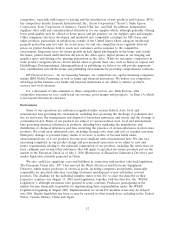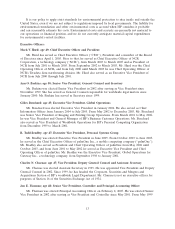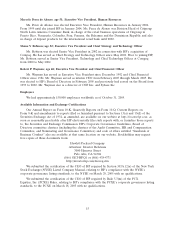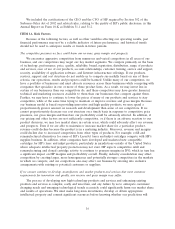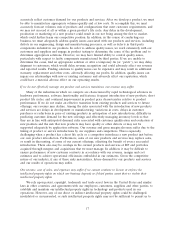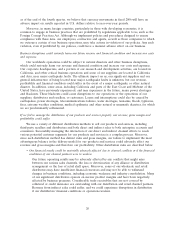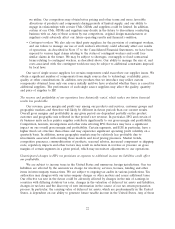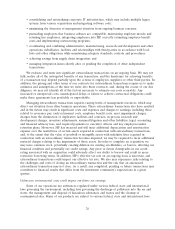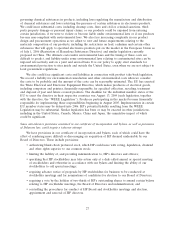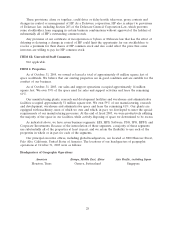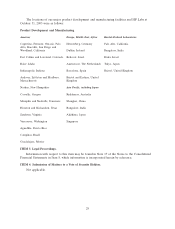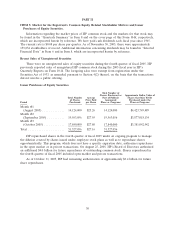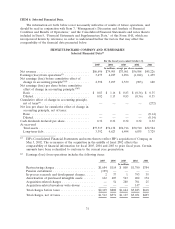HP 2005 Annual Report Download - page 26
Download and view the complete annual report
Please find page 26 of the 2005 HP annual report below. You can navigate through the pages in the report by either clicking on the pages listed below, or by using the keyword search tool below to find specific information within the annual report.we utilize. Our competitors may obtain better pricing and other terms and more favorable
allocations of products and components during periods of limited supply, and our ability to
engage in relationships with certain CMs, ODMs and suppliers could be limited. In addition,
certain of our CMs, ODMs and suppliers may decide in the future to discontinue conducting
business with us. Any of these actions by our competitors, original design manufacturers or
suppliers could adversely affect our future operating results and financial condition.
•Contingent workers. We also rely on third party suppliers for the provision of contingent workers,
and our failure to manage our use of such workers effectively could adversely affect our results
of operations. As described in Note 17 to the Consolidated Financial Statements, we have been
exposed to various legal claims relating to the status of contingent workers and could face
similar claims in the future. We may be subject to shortages, oversupply or fixed contractual
terms relating to contingent workers, as described above. Our ability to manage the size of, and
costs associated with, the contingent workforce may be subject to additional constraints imposed
by local laws.
Our use of single source suppliers for certain components could exacerbate our supplier issues. We
obtain a significant number of components from single sources due to technology, availability, price,
quality or other considerations. In addition, new products that we introduce may utilize custom
components obtained from only one source initially until we have evaluated whether there is a need for
additional suppliers. The performance of such single source suppliers may affect the quality, quantity
and price of supplies to HP.
The revenue and profitability of our operations have historically varied, which makes our future financial
results less predictable.
Our revenue, gross margin and profit vary among our products and services, customer groups and
geographic markets and therefore will likely be different in future periods than our current results.
Overall gross margins and profitability in any given period are dependent partially on the product,
customer and geographic mix reflected in that period’s net revenue. In particular, IPG and certain of
its business units such as printer supplies contribute significantly to our gross margin and profitability.
Competition, lawsuits, investigations and other risks affecting IPG therefore may have a significant
impact on our overall gross margin and profitability. Certain segments, and ESS in particular, have a
higher fixed cost structure than others and may experience significant operating profit volatility on a
quarterly basis. In addition, newer geographic markets may be relatively less profitable due to
investments associated with entering those markets and local pricing pressures. Market trends,
competitive pressures, commoditization of products, seasonal rebates, increased component or shipping
costs, regulatory impacts and other factors may result in reductions in revenue or pressure on gross
margins of certain segments in a given period, which may necessitate adjustments to our operations.
Unanticipated changes in HP’s tax provisions or exposure to additional income tax liabilities could affect
our profitability.
We are subject to income taxes in the United States and numerous foreign jurisdictions. Our tax
liabilities are affected by the amounts we charge for inventory, services, licenses, funding and other
items in intercompany transactions. We are subject to ongoing tax audits in various jurisdictions. Tax
authorities may disagree with our intercompany charges or other matters and assess additional taxes.
Our effective tax rate in the future could be adversely affected by changes in the mix of earnings in
countries with differing statutory tax rates, changes in the valuation of deferred tax assets and liabilities,
changes in tax laws and the discovery of new information in the course of our tax return preparation
process. In particular, the carrying value of deferred tax assets, which are predominantly in the United
States, is dependent on our ability to generate future taxable income in the United States. Any of these
22


